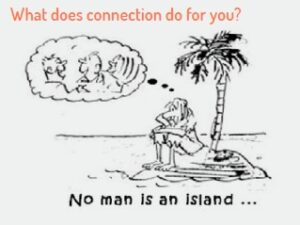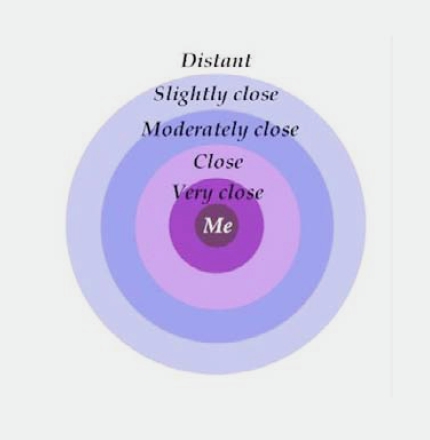 In order to be effective, leaders need to connect authentically with their staff and potential partners. Sales and service people need to connect with their customers. People in different silos in the same firm need to connect with and understand each other. And at a time of increasing diversity, our sensitivity to the rules of engagement across cultural, religious, age and other boundaries assumes great importance.
In order to be effective, leaders need to connect authentically with their staff and potential partners. Sales and service people need to connect with their customers. People in different silos in the same firm need to connect with and understand each other. And at a time of increasing diversity, our sensitivity to the rules of engagement across cultural, religious, age and other boundaries assumes great importance.
All too often these ‘connections’ are relegated to the electronic format. Without knocking text messaging, email and social media, face-to-face interactions are the key to forging lasting, meaningful connections.
We are all part of a much wider web of connectivity than we tend to realize. Some close, some distant, some not immediately visible. All have potential to enliven, enlighten and enlarge our lives.
A lovely Shona saying captures this sentiment: “Chra chimive hachitswane inda – A thumb working on its own is worthless. It has to work collectively with the other fingers to get strength and be able to achieve. One finger cannot pick up a grain.”
Another way to think about interconnectivity: In the brain synapses are the gaps between neurons. Connection-activity in the synaptic space is vital. Using the brain neuron and synapse analogy, psychologist Louis Cozolino coined the term ‘social synapse’ to refer to the gaps between people, and the vital importance of our gap activity.
Of course, there are some who won’t want to connect with you, and others who you don’t want to network with. And that’s OK. Discernment has its place.
Connection requires conscious intention and attention on the part of a leader. We can’t trust in power but we can use the power of trust. How ready are you to connect – in person?
Are you available? I find it sad that according to the judge in the Oscar Pistorius trial (Thokozile Masipa), her grandchildren get to see her only by appointment. Get too busy, get too immersed in electronic communication, allow a personal assistant to screen out phone calls – and you may find yourself cut off from important connection opportunities.
Do you allocate your connection time effectively? I see a number of top executives who devote an inordinate amount of time ‘oiling the squeaking wheels’ but not making time to be with the less vociferous but equally valuable.
Do you divide time between your work, family and social time? All areas where forging connections is important to maintain balance. A senior executive’s son who was being groomed to take over the business, was performing badly at work. One day he was summoned to his father’s home after work ended. The father was wearing a reversible hat, the facing side showing a message that said “Boss.” He told his son that he was fired and then turned the hat around to reveal another message that said “Dad.” He put his arm around his son and said: “I hear you just lost your job. Is there anything I can do to help?”
Do you have ‘getting to know you’ sessions with staff? Don’t do this in your own office. This takes them out of their comfort zone, and doesn’t make for easy, two-way communication. Why not a walk in a nearby park instead?
We can learn from Studdert Kennedy, an army chaplain in the First World War. He refused to give sermons behind the lines, and chose instead to spend his time with the common soldiers in horrific conditions in the trenches, not preaching, but just being with them; coming alongside them in their need. He’d often hand out a Woodbine cigarette, and became known as Woodbine Willy. Years later when he died, his simple funeral was attended by hundreds of thousands of people. A single packet of Woodbines was placed on top of the coffin.

Do you value a warm handshake? The practice dates back to the 5th century BC in Greece. Handshakes were an expression of peace, showing that neither person was carrying a weapon, and symbolized equality, a pact of trust, a move from being distant to being close. A warm, sincere handshake sums up a right attitude to connections. (Health considerations and cultural rules may apply in certain situations).
Are you real?
A lesson from Margery Williams (book: The Velveteen Rabbit) is that true connecting and belonging happens when we are open and real, when we come out of our shells and take off our masks. Vulnerability is not a weakness to be covered up. It is an acknowledgment that you are not flawless and that you don’t know it all. As a leader, you may have many acquaintances but few deep connections. To how many can you ‘expose’ yourself by saying: “I’m not sure what to do…. This scares me … What if we fail?….”
An example is how millions instantly connected to Susan Boyle during and soon after her Britain’s Got Talent audition. The cynical judges and audience were immediately won over the instant this slightly frumpy, midlife, socially awkward, rural Scottish lady (who was affected by being starved of oxygen at birth) began to sing. Her authenticity evoked basic human yearnings and dreams, hopes, a need for acceptance. Within a week following her performance, over 20 million ‘hits’ were registered on YouTube.
So it’s not about having charisma, that rare personal quality that can arouse devotion and enthusiasm based on personal magnetism or charm. Being yourself and being comfortable with yourself provides the necessary ‘presence’.
Are you empathic?
The German philosopher Robert Vischer coined the term “einfühlung”. Imagine you’re in the passenger seat and you’re slamming on your brake pedal to avoid an accident. For me, that’s einfühlung, or empathy: a prime emotional intelligence characteristic. Feeling as if you were the other.
 Listening attentively is the most important route to empathy. We cannot really understand and empathize without attentive listening. Maya Angelou said: “People will forget what you said, people will forget what you did, but people will never forget how you made them feel”.
Listening attentively is the most important route to empathy. We cannot really understand and empathize without attentive listening. Maya Angelou said: “People will forget what you said, people will forget what you did, but people will never forget how you made them feel”.
Practicing listening (a skill) and possessing empathy (a characteristic) also steers us away from being dominating, passively aggressive or compliant when communicating. Instead, we may show appropriate assertiveness – I’m OK, You’re OK.
When you know the other well, shared silences can be good for bonding. Having empathy allows you to know when the other needs to be left alone, and the connection – task suspended.
Do you use stories?
Story is linked to the evolution of the human brain. Stories show how we are connected to ourselves, to other people (present and past) and to the world. In this way, a story is a metaphor – a bridge between our experience and another’s experience.
If vulnerability, openness, and authenticity are prerequisites for connecting emotionally, then the use of story (whether personal, brand messages, presentations, and other communications) helps us to move from simply sharing data and information, to facilitating understanding, wisdom, and connection. (The ‘Big Data’ age is upon us and doesn’t necessarily make for better understanding and connection.)
A Finance Director battling to get through to staff in his conversations and presentations, told me that since paying attention to story patterns, utilizing illustrative and personal story, and introducing metaphor and imagery, his connection-rate and credibility improved markedly. He now gets lots of unsolicited, positive feedback.
Do you keep it broad and light?
Try and be a deep generalist – a move from knowing a lot about a little, to knowing enough about a lot (stopping short of being a know-it-all!) According to professor Michael Watkins, a general manager/executive generalist needs to talk the same language or jargon, and understand the mental model prevalent in the other person’s field of expertise. If you know something about the other’s fields of expertise, interests and cultural norms, the way to good dialogue is smoothed. This also helps to avoid boring ‘cocktail party’ trivia.
Do you allow your people to participate on equal terms in conversations about strategy and issues that the organization is facing? They’ll appreciate it and will act accordingly – like giants, not pygmies. People will often surprise you with the quality of their insights and suggestions. But at the same time, general managers need to realize that ‘heavy’ conversations leave people exhausted and encourage future avoidance. Try laughter – which reduces stress and puts relationship friction into perspective, and contagiously connects. Or at least have a ready smile!
 Do you appreciate the other?
Do you appreciate the other?
There is ample evidence that generous affirmations and praise trump criticism and correction. Positive appreciation and appreciative inquiry go a long way to shifting stuck frames of reference and resistance, and facilitating constructive engagement. Practicing non-dualistic thinking also helps one to quickly orientate to understanding the other’s viewpoint. When AND applies instead of OR, and we can see the flip side of our coin, then appreciation is more likely to flow. Which is not flattery, by the way.
Do you practice compassion?
Between face-to-face exchanges, I advocate building compassion via compassion-awareness techniques such as meditation.
This subject is an article on its own, but it’s about using mindfulness practices to alter our neural pathways. We alter the way we think about, and relate to others. We become aware that our being precedes our doing. We’d like to be with people rather than over people. (People know immediately and with certainty if we are not acting, talking and listening congruently).
This means living from an unhurried, still, quiet place within – and not approaching the forging of connections as a chore.
What does connection do for you?
 “No man is an island,” wrote John Donne. Instead:
“No man is an island,” wrote John Donne. Instead:
Strong connections in an organization foster engagement, performance, stay-ability. An intrinsic motivation component is that of deep social connection.
Strong connections with customers, suppliers and stakeholders foster partnerships, loyalty and helps the bottom line.
Social connections are good for us. “Studies indicate that “social capital” is one of the biggest predictors for health, happiness, and longevity”.
A move from hierarchical to open leadership and frequent connection with valued sources keeps you in touch with what’s happening, and gives you the opportunity to connect and leverage a wider range of ideas to good advantage – necessary in this age of ‘infobesity’.
At the personal level, with close family and friends:
We share each other’s woes,
our mutual burdens bear;
and often for each other flows
the sympathizing tear.
(by John Fawcett (1740-1817) – Blest be the tie that binds, The United Methodist Hymnal Number 557)
There are no easy, quick fixes but the rewards of establishing ties that bind are more than worth the effort. Are you open to enliven, enlighten and enlarge your life?
Connection reflection & action
As far as I know, no one on their deathbed has ever said ‘I should have spent more time on strategy and policy’. They’re far more likely to reflect that appreciating and connecting to others, showing love – at home and at work, would have made their lives more worthwhile.

- Where do you stand? Link a name to each of the pictures below and decide where on the circles of connection you currently place the most important people in your life.
Add workplace colleagues, subordinates, contacts, etc.
2. How did you come to arrive at this point? Think about why you positioned these people where you have. What are the elements that have made for good or bad relationships and connections? What has been your ‘complicity’ in making them work or fail?
3. Where to now? Think about where on your circles you would want these relationships to be in the future. Which do you wish to deepen or to cool? And what is your plan (thinking, feeling, acting) in each case? (This might mean writing a letter to a relative or child you have lost touch with, making a point of going for a walk with a subordinate who has been taken for granted, inviting a colleague to breakfast, allocating less time to unnecessary formal meetings, email and social media – and more time to forging meaningful one-on-one connections, finding out more about other’s expertise and interests, examining your own hesitancies, fears, stereotyping, etc…. )
Graham Williams is a certified management consultant, thought leader, business narrative practitioner and author based in Cape Town, South Africa. He can be reached at https://www.haloandnoose.com
